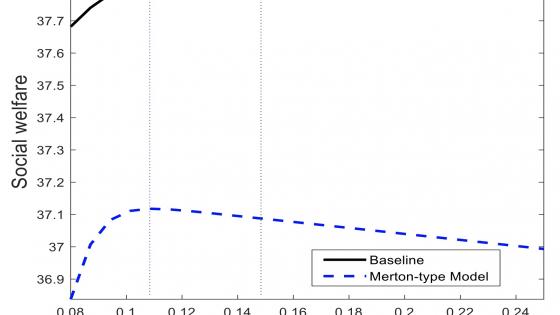The Global Crisis extended the view among regulators that maturity and liquidity mismatch in the financial system prior to the Crisis were excessive and not properly addressed by the existing regulatory framework (e.g. Tarullo 2009). When the first losses on subprime mortgage exposures arrived in 2007, investment banks, hedge funds and many commercial banks were heavily exposed to refinancing risk in wholesale debt markets. This risk was a key lever in generating, amplifying, and spreading the consequences of the collapse of money markets during the crisis (Brunnermeier 2009, Gorton 2009).
Basel III has aimed to limit (internationally active) banks' exposure to liquidity risk through two new minimum standards: the liquidity coverage ratio (LCR) and the net stable funding ratio (NSFR). The LCR standard aims at ensuring that banks have adequate high-quality assets to survive stressed liquidity conditions over a 30-day period (BCBS 2013). The standard entered into force on 1 January 2015 with a phase-in period that will be concluded on 1 January 2019. The NSFR standard aims at reducing banks' maturity mismatch by requiring institutions to have a sufficient amount of stable funding in relation to the liquidity and maturity of their assets (BCBS 2014). Its definition has been the outcome of long discussions involving many calibration choices. The NSFR is planned to come into force on 1 January 2018. Academic work of direct relevance to inform the cost-benefit analysis of this standard is scarce.
Fit in the literature
The academic literature has found several theoretical mechanisms that may justify a regulatory intervention such as the NSFR. Some of them share the idea that banks' refinancing needs during a liquidity crisis produce negative pecuniary and non-pecuniary externalities (Perotti and Suarez 2011). This may happen because refinancing needs force banks to undertake fire sales whose impact on asset prices contributes to tightening financial constraints (Stein 2012). Excessive short-term borrowing may also arise because public liquidity support to distressed institutions during crises makes bank leverage decisions strategic complements (Farhi and Tirole 2012), or due to an unresolved conflict of interest between long-term and short-term creditors that leads to a ‘maturity rat race’ (Brunnermeier and Oehmke 2013). While conceptually very valuable, most papers in the literature rely on models with a highly stylised time dimension (typically with two or three dates), which is unsuitable for calibration.
In a new paper, we provide a first attempt to fill this gap (Segura and Suarez 2016). We develop and calibrate a tractable infinite horizon model focused on banks' maturity transformation function. After calibrating the model to Eurozone banking data for 2006, we quantify the extent to which banks' average debt maturities were excessively short and the size of the welfare gains that would have been associated with regulating liquidity risk in such an environment. We also use the model to quantify the welfare impact of the introduction of the NSFR in such an environment.
To make a long story short, while we find a strong rationale for limiting banks’ maturity mismatch, we also find that the reduction in maturity transformation achieved with the NSFR is likely to be too drastic, actually implying a net welfare loss.
The model
In our model, banks finance long-term assets by placing non-tradable debt among unsophisticated savers. Short maturities are attractive to these savers because they buy bank debt when they are patient, but may suffer shocks that turn them impatient, in which case waiting until the debt matures to recover its principal is a source of disutility. We assume, however, that banks are exposed to systemic liquidity crises – sudden episodes in which they are unable to place debt among the unsophisticated savers and they have to (temporarily) rely on the funding provided by some crisis financiers at a price that is increasing in banks’ aggregate demand of funds. At an initial non-crisis period, banks decide their capital structure by trading off the lower interest cost of short-maturity debt with the cost of refinancing during crises.
In their uncoordinated, competitive capital structure decisions, banks neglect the impact of their refinancing needs on the equilibrium cost of crisis financing, which tightens the constraint that all banks have to satisfy if they want not to default during crises, thus damaging the efficiency of the maturity transformation process.1 As a result, in the unregulated equilibrium, debt maturities are excessively short and crisis financing is excessively costly, which eventually reduces the aggregate amount of leverage that the banking industry can sustain. We find that social surplus can be increased by lengthening the maturity of bank debt, while simultaneously increasing debt issuance. Moreover, the social planner can implement such debt structure by limiting banks’ choice of excessively short debt maturities.
Calibration and quantitative results
To calibrate the model to Eurozone data for 2006, we combine information about banks' liability structure and the maturities of their various classes of debt to estimate the refinancing needs of a representative Eurozone bank in a crisis. The calibrated model matches banks' wholesale refinancing needs per month or, equivalently, an average wholesale debt maturity of 2.8 months.
Our analysis indicates that reaching social efficiency would require lengthening that maturity to 3.3 months. Although this increase may look modest, it would allow banks to remain solvent in a crisis with an equity ratio of 4.0% rather than 5.2%, and would generate a net welfare gain with a present value of €105 billion (0.8% of the unlevered value of bank assets). These gains can be broken down into a sizeable rise by €424 billion (3.4%) in the total market value of banks and a sizeable fall of €319 billion (21%) in the present value of the rents appropriated by crisis financiers.2
Assessing the NSFR
We check whether the lengthening of bank debt maturity implied by the new NSFR regulation is a good approximation to what we find to be optimal. The NSFR of a bank is the ratio of its available stable funding (ASF) to its required stable funding (RSF), and the new standard will require it to be larger than one. The ASF is measured taking into account the characteristics of the bank’s liabilities under the principle that longer maturity and more stable funding should be attributed higher ASF factors. The overall ASF emerges as the factor-weighted sum of its components. In turn, the RSF is measured from the characteristics of the bank’s assets under the principle that longer maturity and less liquid assets should be attributed higher RSF factors. The overall RFS emerges as the factor-weighted sum of its components.
We rely on the proposed definition of the NSFR in BCBS (2014) to derive a conservative estimation of that standard for each possible debt structure choice of banks in the context of our model.3 After this, we solve the equilibrium of the economy under the restriction that banks must operate with an NSFR above one. We find that the regulation is binding and would lead banks to set an average wholesale debt maturity of 8.0 months, 5.2 months longer than in the unregulated equilibrium and 4.7 months longer than in the optimally regulated economy. The total surplus generated under this solution is not only obviously lower than under the optimally regulated maturity, but also 9.6% lower than in the unregulated economy.
Conclusions
The main implications of our results are as follows:
- The pecuniary externalities associated with banks’ refinancing needs during crises have a substantial welfare impact that justifies debt maturity regulation.
- Optimal regulation would imply an increase in the average maturity of banks’ wholesale debt of 0.5 months (from 2.8 months in the unregulated economy to 3.3 months in the optimally regulated economy).
- The reduction in maturity transformation envisaged by NSFR regulation is, through the lens of our model, excessive.
We think these results raise a call for caution regarding the desirability of the initially proposed calibration of the NSFR and may suggest to reconsider the factors assigned to the different balance sheet items that contribute to ASF and RSF. Our conclusions should nevertheless be taken with prudence as some issues left out of the current paper, such as the endogenous determination of the probability of a systemic crisis, may imply we are understating the need for a more important lengthening of banks’ average debt maturity. We believe further quantitative research on the social value of maturity transformation is of utmost importance.
Authors’ note: The views in this column are exclusively those of the authors and should not be attributed to the Bank of Italy or any of the institutions to which the authors are affiliated.
References
Basel Committee on Banking Supervision (BCBS) (2013) “Basel III: The Liquidity Coverage Ratio and Liquidity Risk Monitoring Tools”, Bank for International Settlements, January.
Basel Committee on Banking Supervision (BCBS) (2014) “Basel III: The Net Stable Funding Ratio”, Bank for International Settlements, October.
Brunnermeier, M (2009) “Deciphering the Liquidity and Credit Crunch 2007-08”, Journal of Economic Perspectives, 23, 77-100.
Brunnermeier, M and M Oehmke (2013) “The Maturity Rat Race”, Journal of Finance, 68, 483-521.
Farhi, E and J Tirole (2012) “Collective Moral Hazard, Maturity Mismatch and Systemic Bailouts”, American Economic Review, 102, 60-93.
Gorton, G (2009) “Slapped in the Face by the Invisible Hand: Banking and the Panic of 2007,” paper presented at the Federal Reserve Bank of Atlanta's Financial Markets Conference, May 11-13.
Perotti, E and J Suarez (2011) “A Pigovian Approach to Liquidity Regulation”, International Journal of Central Banking, 7, 3-41.
Segura, A and J Suarez (2016) “How Excessive Is Banks’ Maturity Transformation?”, CEPR DP 11111.
Stein, J (2012) “Monetary Policy as Financial-Stability Regulation”, Quarterly Journal of Economics, 127, 57-95.
Tarullo, D (2009) “Regulatory Reform”, Testimony before the Committee on Financial Services, U.S. House of Representatives, Washington, D.C., October 29.
Endnotes
[1] To survive a crisis, the bank must have sufficient equity value to be able to absorb the excess cost of refinancing its maturing debt during it. This imposes an upper limit on the amount and immediacy of its debt. Similarly to Stein (2012), the interaction between pecuniary externalities on the cost of funds during crises and such a constraint is a source of inefficiency.
[2] To put these numbers in perspective, if the 424 billion gain in banks' market value were appropriated by bank equityholders, it would imply a windfall gain equivalent to 36.6% of equity value in the unregulated equilibrium.
[3] By "conservative" we mean that, if anything, our estimation will make the NSFR standard look looser than as currently proposed.



